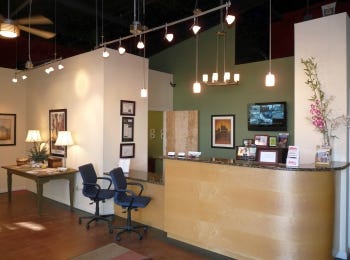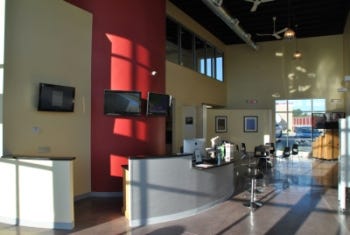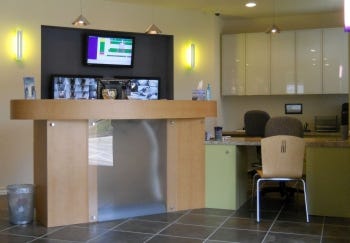The self-storage industry is not just breaking design stereotypes, it's crushing them. From bigger, brighter offices to better parking lots, today’s facilities are mimicking retail stores and luring potential renters. The bonus? Superior design improves functionality for staff, increases customer satisfaction and can even make a facility more "green."
May 12, 2014
By Kay Miller Temple
The self-storage industry is not just breaking design stereotypes, it's crushing them. From bigger, brighter offices to better parking lots, today’s facilities are mimicking retail stores and luring potential renters. The bonus? Superior design improves functionality for staff, increases customer satisfaction and can even make a facility more "green."
The Upscale Office
Today's office design targets customers, keeping in mind that 60 percent of self-storage rental agreements are signed by women, according to Bruce Jordan, president of San Clemente, Calif.-based Jordan Architects Inc. The customer-service counter should be the first element prospects and renters see when they walk through the door. “The office should say safety, organization and management control over the facility, and be presented in a bright, cheerful and friendly way,” Jordan says.
Self-storage offices, once reduced to small areas, are now bigger. Much bigger. In recent years, office-space requirements have increased nearly 150 percent, according to Ariel Valli, president and principal architect of Valli Architectural Group in Aliso Viejo, Calif. “We have completed offices in the 2,000- to 2,500-square-foot range, with customer seating, child-play areas, conference rooms, vending machines, mailing and shipping desks, and even computer work modules,” he says.
 Within the office space, retail areas remain a prominent focus, says Kenneth Carrell, principal architect for ARE Associates in Lake Forest, Calif. “When I design the retail space, I try and do it like I would a regular retail store,” Carrell says. “I use shelves and end caps for display, and I keep units low so people can see over the top.”
Within the office space, retail areas remain a prominent focus, says Kenneth Carrell, principal architect for ARE Associates in Lake Forest, Calif. “When I design the retail space, I try and do it like I would a regular retail store,” Carrell says. “I use shelves and end caps for display, and I keep units low so people can see over the top.”
Designs that include a sample storage unit can quickly engage a potential tenant. Terry Campbell, executive vice president of operations and vice president of sales and marketing for BETCO Inc., a manufacturer of self-storage buildings in Statesville, N.C., says one trend is to display a unit with a roll-up door and a latch-and-lock system so managers can demonstrate how it works. “There can also be sample unit sizes shown on the floor using colored tape or paint to give a potential tenant an idea of how big a unit size is,” Campbell says.
Some of today's office designs are so evolved that they look like hotel lobbies, says Steve Hajewski, marketing manager for Sun Prairie, Wis.-based Trachte Building Systems, a manufacturer and supplier of self-storage buildings. Items like flat-screen monitors remind customers the facility is equipped with security cameras. “And these amenities are becoming more common even in mid-market sites,” Hajewski says.
 Today's office designs can be described as “a well-appointed environment,” says Ted Culbreth, vice president of sales and marketing for Select Building Systems Inc., a Boerne, Texas-based design-build general contractor that provides turnkey construction services to the self-storage industry. In addition to special finishes, cabinets and granite countertops, lighting and a big-space feeling are important. “It's the lighting that you would see in high-end retail,” he says. “Lots of glass, lots of openness so customers can see in and feel comfortable before they ever walk in.”
Today's office designs can be described as “a well-appointed environment,” says Ted Culbreth, vice president of sales and marketing for Select Building Systems Inc., a Boerne, Texas-based design-build general contractor that provides turnkey construction services to the self-storage industry. In addition to special finishes, cabinets and granite countertops, lighting and a big-space feeling are important. “It's the lighting that you would see in high-end retail,” he says. “Lots of glass, lots of openness so customers can see in and feel comfortable before they ever walk in.”
The self-storage look is definitely different from past years, says Charles Plunkett, CEO of Capco Steel Inc., a San Antonio-based steel supplier and erector of metal buildings and RV and boat storage. “Almost every office constructed in modern times is open, airy, and has a feel of a country-club reception area or a modern retail facility,” he says. “Customers like a lot of windows, natural light and an inviting atmosphere.”
A well-organized, efficient work space for the manager should also be incorporated into the design. Plunkett likes the idea of adding a small break room for the manager. Frank Relf, owner of Frank G. Relf Architects in Huntington Station, N.Y., agrees. “Customers and staff benefit from having an area where they are able to sit down and have a discussion about self-storage or to complete paperwork,” he says.
Parking: Following the Rules of Others
One challenge in facility design is balancing jurisdictional requirements, customer needs and rental footage in the name of parking spots. Overall, requirements are not very flexible. “All parking requirements that are mandated by the local municipality also govern for how many and where they are placed,” Relf says. “Most self-storage facilities do not require the amount of spaces imposed on them by the authorities.”
In some cases, using a little extra paint can provide compliance with parking codes. Campbell says to consider painting parking spaces in front of a facility's units. “I've seen this done several times. It appeased the local municipalities and didn’t really cost any space to do it.”
Just as municipal codes can't be ignored when it comes to creating the parking layout, neither can customer needs—or behaviors. Consider a design where no customer ever has to back up a vehicle. “Backing up is when they’ll hit your buildings,” Hajewski says.
 “Function, function, function” is Valli’s advice. “Make sure there is easy access, adequate width and room for turning motions,” he says. “Although they can vary wildly from jurisdiction to jurisdiction, parking rates should be at about one space per 7,500 square feet of gross-building area.”
“Function, function, function” is Valli’s advice. “Make sure there is easy access, adequate width and room for turning motions,” he says. “Although they can vary wildly from jurisdiction to jurisdiction, parking rates should be at about one space per 7,500 square feet of gross-building area.”
For facilities in regions with snow—and subsequent snow melt—Relf says parking design must accommodate the temporary placement and removal of snow.
Gaining Green Points
Although there may be few customers who will arrive at your facility via a bike or motorcycle, there are advantages to having dedicated parking for two-wheelers, namely "green points." More of today's building codes require eco-friendly elements such as motorcycle and bike parking, even electric car-charging stations. New-facility and renovation designs look once, twice and three times at green-element implementation and cost.
However, it's difficult to get very far with eco-friendly plans since many of these amenities add cost with little return on investment. ��“A lot of our developers wring their hands and try to ferret out those additions that give them the best economic return or the best return as far as being pleasing to the customer that they are a green facility,” Culbreth says.
However, there are simple green elements that shouldn't be overlooked. Employing natural light, proper office location and green exterior design can add to the bottom line, Carrell says. “Using the building's orientation can reduce heating and cooling costs; and using the latest materials like spray-foam insulation can also help.” Other facilities use water-catchment systems to water their landscaping, adds Plunkett.
Some would say self-storage in it's traditional state is inherently green already. “People don't realize that self-storage has a lot of green elements that exist by virtue of the way [the buildings] are typically constructed,” Plunkett says. “This includes the use of metal framing, which includes a high percentage of recycled content. And most of the metal is manufactured within a reasonably short distance of the facility.”
Self-storage design is eclipsing the old-fashioned look that says “obviously rental.” From country-club styling to open, bright spaces, a well-designed facility will help an operator attract and retain customers. But there’s another bonus, says Stephanie Tharpe, district sales manager for A Plus Storage, which operates 12 facilities in Tennessee. “My favorite part is when a customer walks in and says, ‘Wow, this is storage?’”
Kay Miller Temple is a physician and recent graduate from the master’s program at Arizona State University’s Walter Cronkite School of Journalism and Mass Communication. To reach her, e-mail [email protected].
You May Also Like





